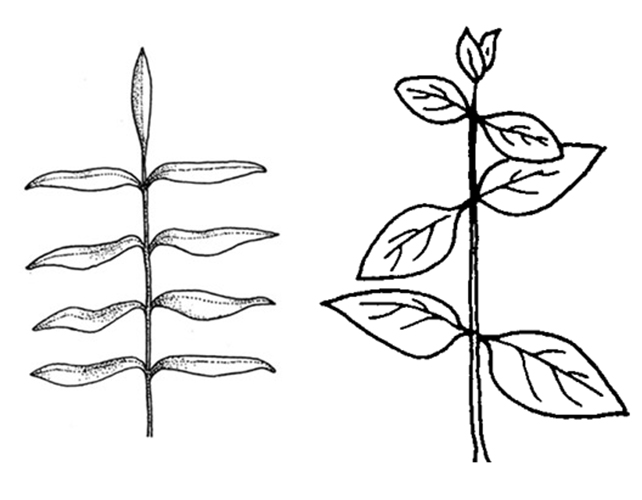Salix L.
willow
Salicaceae
mainly temperatetemperate:
(adj) of the climatic zone between boreal and tropical
regions in the northern hemisphere
At least 61 species and accepted hybrids plus numerous cultivated hybrids and varieties
worldwide
known to be a significant weed in some countries
terrestrialterrestrial:
(adj) growing on land as opposed to living in water
to amphibiousamphibious:
(adj) of a plant able to live on land or in water
, or occasionally inundated shrubs or trees
Clones sometimes formed by rhizomes; rhizomes branching sympodially. Leaves alternatealternate:
(adj) (of leaves) bearing one leaf per node; placed singly on the stem at different heights
 , rarely oppositeopposite:
, rarely oppositeopposite:
(adj) (of leaves) two leaves per node; in pairs on opposite sides of an axis
 , deciduousdeciduous:
, deciduousdeciduous:
(adj) shedding of parts at the end of their growing period, as with leaves; those trees or shrubs that drop their leaves at the end of the season
or marcescentmarcescent:
(adj) withering but not falling off
, petiolatepetiolate:
(adj) relating to or in the form of a petiole; bearing petioles
, often stipulate; leaf bladeblade:
(n) (syn. lamina) the flat, expanded part of a leaf, frond, or petal (excluding, e.g., the petiole)
 variously shaped, typically linear; margins entireentire:
variously shaped, typically linear; margins entireentire:
(adj) having a continuous margin that is not toothed or lobed
 to toothed, often glandular. Catkins appearing before, with or after the leaves, sessilesessile:
to toothed, often glandular. Catkins appearing before, with or after the leaves, sessilesessile:
(adj) attached directly, without a stalk
 or on terminating branchlets, erect or spreading, rarely pendulous; each flower subtended by 1 floral bractbract:
or on terminating branchlets, erect or spreading, rarely pendulous; each flower subtended by 1 floral bractbract:
(n) a modified leaf near a flower or inflorescence, often reduced, sometimes large and/or petaloid; also glumes, lemmas, and paleae of grass spikelets
 . Perianthperianth:
. Perianthperianth:
(n) collective term for the calyx and corolla of a flower; also used for floral whorl(s) in which the calyx and corolla cannot be resolved; any of the leaves or bracts surrounding the sex organs of bryophytes
 reduced to glands: 1 adaxialadaxial:
reduced to glands: 1 adaxialadaxial:
(adj) pertaining to the side facing toward the axis, as in the upper surface of a leaf
and 1 abaxialabaxial:
(adj) the side facing away from the axis, as in the underside of a leaf
or absent; male flower stamens 2 to many, filaments free or united; female flower sessilesessile:
(adj) attached directly, without a stalk
 or stipitatestipitate:
or stipitatestipitate:
(adj) borne on a stipe or stalk
, bladeblade:
(n) (syn. lamina) the flat, expanded part of a leaf, frond, or petal (excluding, e.g., the petiole)
 , sometimes bifurcatebifurcate:
, sometimes bifurcatebifurcate:
(adj) split into two
, stigmasstigma:
(n) the portion of the pistil that is receptive to pollen
2, entireentire:
(adj) having a continuous margin that is not toothed or lobed
 or each 2-lobed.
or each 2-lobed.
permanently or seasonally wet, inundated or waterlogged sites; channels, ditches, riparianriparian:
(adj) growing by rivers or streams; of, adjacent to, or living on, the banks of a river, lake, pond, etc.
zones (creeks, springs, rivers, streams, ponds, lagoons, lakes), wetlands (fens, bogs, marshes, swamps), wet meadows, floodplains, wet tundra, and snowbeds
Salix is a large genus containing over 550 species and hybrids. Members of this genus are highly variable and there are many hybrids, making it difficult to identify particular species.